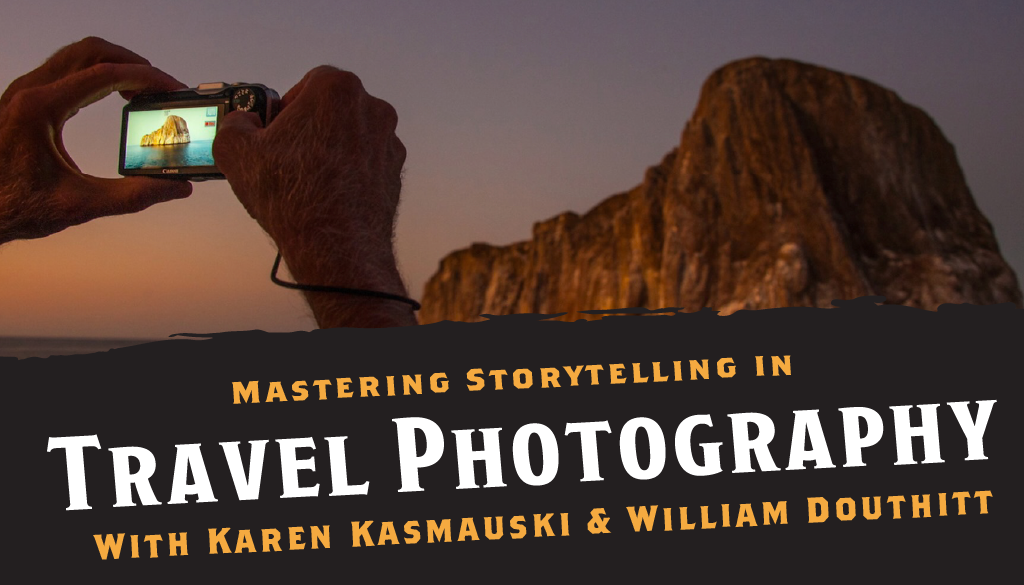20 Feb Take Your Travel Photography to the Next Level

Join photographers Karen Kasmauski and William Douthitt for an immersive week-long class, Mastering Storytelling in Travel Photography, from April 27–May 3, 2025. Whether you’re a beginner or an experienced photographer, this hands-on experience will help you turn your travel photos into powerful visual stories.
Learn how to approach new locations, build compelling narratives, and improve your composition, lighting, and editing skills. With guidance from two seasoned photographers, you’ll create images that truly capture the heart of your journey.
Want to learn more? Check out the blog post below. Reserve your spot today!
JCCFS:We asked Bill Douthitt and Karen Kasmauski to share a bit about themselves—their backgrounds in photography and how their journeys began. Here’s what they shared:
Bill Douthitt spent 34 years as an editor for National Geographic Magazine, working across various editorial groups. Starting as a designer and photographer, he transitioned to photo editing and later into digital media. He created the first CD-ROM version of the magazine and managed NatGeo’s section during the website’s launch. Bill also spearheaded EarthPulse, the organization’s first project spanning magazine, television, and digital platforms to spotlight conservation issues.
After earning a master’s degree in science writing from Johns Hopkins University, Bill authored stories for National Geographic, including the December 2006 cover story on the Cassini mission to Saturn. Later, he served as managing editor for the magazine’s single-subject “bookazines,” covering topics like history, exploration, and the environment. Following his tenure at National Geographic, Bill became Director of Photography at Science Magazine, where he also blogged about using photography to visualize scientific concepts.
Karen Kasmauski has photographed for major publications and organizations, including National Geographic Magazine, the Smithsonian, The New York Times, and the Centers for Disease Control. Over her career, she produced 25 stories for National Geographic, exploring topics from Alaskan oil’s environmental impact to Japanese women’s contemporary lives. Her work on global health, population, and aging earned National Magazine Award nominations and formed the foundation for her acclaimed book Impact: From the Frontlines of Global Health.
Karen’s global health work has been featured in exhibitions at the Carter Center, the CDC, the National Academy of Science, and National Geographic. Her TEDx talk expanded on these themes. She co-produced a documentary, Fall Down Seven, Get Up Eight: The Japanese War Brides, which earned critical acclaim and inspired a Smithsonian museum exhibit on race, migration, and identity.
Karen holds a Knight Fellowship and an M.A. from Ohio University and has taught photography and conservation workshops. She also authored a long-running column for Nikon Magazine and frequently blogs about photography, food, and culture.
Together, Bill and Karen have taught graduate and undergraduate courses in photography, news writing, and science journalism at institutions like George Washington University, George Mason University, and the Maine Media Workshops.
Today, Bill and Karen are dedicated to sharing their extensive storytelling and visual communication expertise, helping others craft compelling narratives and effectively tell their own stories.







JCCFS: Karen and Bill bring enormous amounts of professional experience to the class, working for what is arguably the most prestigious visual publication in the world. Together and jointly, they have worked on magazine projects, books, films, exhibits, and digital media. We asked Karen and Bill to tell us more about their class’s specific technique or process. Here’s what they had to say:
K&B: We’re experienced teachers, well-versed in distilling the elements of communicating complex themes into basic principles that students can apply to their own projects. We focus on learning to see effectively and avoid emphasis on camera or computer technology.
JCCFS: What can students expect to leave your class with?
K&B: In our upcoming class we’ll explore the art of seeing—learning to apply composition, light and timing to make memorable pictures of your experiences. Learning to see can change the way you perceive the world. Good pictures are everywhere. You don’t have to travel to exotic locations to find them.
We’ll also explore telling stories with your pictures. When you visit a location, whether it’s a springtime meadow, a fall forest, or a seashore in summer, what do you feel about that place? What do you want to say about it? How do you capture that in your photography? Karen and Bill will help you develop a point of view when you travel and explore techniques that give variety to your pictures.
Finally, we’ll delve into editing. Imagine you’ve had a wonderful experience visiting a new area and taking hundreds of pictures. Now, how do you sort out the best ones, and organize them into a story to share with others? Bill edited hundreds of National Geographic projects, often reviewing tens of thousands of pictures, taken by some of the world’s best photographers, to select just the few dozen that best represent the story. He’ll share his editing skills with you, comparing similar frames of a subject to find the best choices, and organizing the results into an edit you can use for a book, publish online or share with family and friends.
This is not a technical class. These days, all cameras are good. You can make wonderful pictures whether you’re using a cellphone or a high-end DSLR. We’re focused on helping you develop your seeing and story-telling skills.
JCCFS: What do you enjoy most about The Folk School?
K&B: We enjoy the environment–a dedicated place allowing students and teachers alike the time and space to focus on developing their skills. We also enjoy the chance to talk with other teachers, and when time allows, witness their expertise.






JCCFS: Where do you draw inspiration for your work?
Bill has a deep interest in the impact of science and technology on human development. That has driven much of his focus at National Geographic.
Karen with undergraduate majors in anthropology and religion, has a strong interest in human culture. Her major National Geographic projects and two major books have deeply explored global health concerns.
JCCFS: What’s one piece or craft object you’ve made recently that you are proud of, and why?
Bill has focused his skills recently on redesigning the print and digital publications of a local citizen’s activist group, making them more visual and accessible to readership.
Karen is involved with mentoring young women to use photography as a tool to communicate conservation concerns.
JCCFS: What tips would you give a student or aspiring craftsperson? Anything you wish you had known earlier in your career?
K&B: Perhaps the most important thing is to always be curious, and ask “why?”
JCCFS: Where can folks find you if they want to stay up to date on your work?
Upcoming Class with Bill & Karen
Mastering Storytelling in Travel Photography
April 27 – May 3 , 2025
Are you ready to elevate your travel photography and create unforgettable images? Join our workshop to discover powerful storytelling techniques that will transform your trips into captivating visual narratives. During this immersive experience, you’ll learn how to assess new locations, craft compelling stories, enhance composition, play with light, and editing magic. Get ready to capture the essence of your travels through the lens and share your adventures with the world!




No Comments